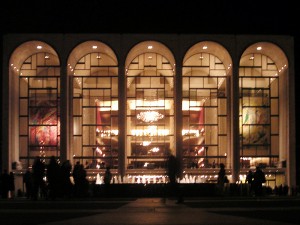
Reviewing a new history of the Metropolitan Opera in yesterday’s Wall Street Journal, I write: “The Met has never enjoyed the services of a shrewd and practical visionary. There is no one in the company’s annals to set beside Henry Higginson, who created the Boston Symphony in 1881; or Oscar Hammerstein, whose Manhattan Opera combined integrated musical theater, new repertoire and stellar artists before being bought out by the Met in 1910; or George Balanchine and Lincoln Kirstein, who invented the New York City Ballet in 1948; or Harvey Lichtenstein, who reinvented the Brooklyn Academy of Music in the 1980s.”
To read the review, google: wall street journal affron metropolitan opera book review
Also, if you were not able to access my recent Wall Street Journal Op-Ed on the Met, in which I opined that the 4,000-seat Metropolitan Opera House is “already a relic,” google: wall street journal joseph horowitz metropolitan opera union trouble
Common to both pieces is the notion that “grand opera” as a defining variant of the operatic experience is increasingly a thing of the past. Like the “culture of performance” and the “performance specialist,” it will ultimately be viewed as a twentieth century anomaly. Opera in America will increasingly transpire in smaller spaces, prioritizing an intimate theatrical experience.

In this regard, we might note that almost all European houses have small black box theaters for the creation and presentation of smaller forms of music theater. Germany has 83 full time opera houses. I would say the large majority have such smaller venues.
The USA only has about 6 or 7 genuinely functional opera houses (e.g. the Met, Chicago Lyric, San Francisco Opera, Houston Grand Opera, and Santa Fe) and none of them have a smaller venue. To make matters worse, the USA ranks 39th in the world for opera performances per capita. With so little support for opera, small companies use pick up musicians in various kinds of rental facilities to create opera – often with only piano accompaniments. The inherent mediocrity of these circumstances often produce is rationalized with polemic about freedom, innovation, entrepreneurship, etc., etc.
Which system will work best for the creation of new forms of music theater, Europe’s subsidized smaller venues, or the underground efforts of Americans? As opera continues to fade, I would say that the infrastructure and funding provided by the European system will better enable a transition to smaller forms of music theater. As an example, I might mention how Ensemble Fabrik in Cologne is now touring the major venues of Europe with an excellent production of Harry Patch’s “Delusion of the Fury” with instruments entirely recreated based on his models. It would be extremely difficult for Americans to find the resources for such a project. For more info about it see:
https://www.youtube.com/watch?v=U6Ef2C-jgQw
I also notice that many in America’s musical community learn little from observations of the European system. It’s as if they are blinded by a sense of national superiority that is often not based on fact.
Philadelphia has the Academy of Music for large scale opera productions and the Kimmel Center’s Perelman Theater (650 seats) for smaller productions.
The problem in Philadelphia is that it ranks 175th in the world for opera performances per year (in spite of having the 9th largest metro GDP in the world.) It’s not in much of a position to have substantial season for either space. Philadelphia has about 42 opera performances per year while major houses like the Met or the Vienna State Opera do 300. Actually, with multiple houses Vienna has 578, Berlin 523, Paris 437, Moscow 424, etc.
The Philadelphia Opera is only doing two productions in Perelman in the next season for a total of 8 performances. With such limited efforts, can we expect to complete the exploration and learning necessary to develop new and smaller forms of opera more suited to the 21st century? Americans like to say you get what you pay for, until it comes to the arts, then they make all sorts of excuses.
I don’t mean to quibble with Mr. Osborne’s point that opera is a different animal in this country than it is in Europe. However, I do wonder whether or not we should have some regard for the quality of all the productions cited for European venues. Does Mr. Osborne want to comment on whether opera in the more obscure European locales is generally worth seeing? I am curious because my very limited experience says it isn’t. Of course, it would be great to have more than 83 opera houses in the US, but I am also going to assume that the 7-8 mentioned by Mr. Osborne are substantially better than the mean of the 83 in Germany. His numbers, I should add, do not overly surprise me, given that we are not a motherland of the operatic art form. I might note that, until just a few years ago, New York at least could actually boast of something like 480 operas per season. And I’m pretty sure many American opera lovers do grasp the fact that they are not necessarily the “tops” of the world opera scene. Commentators imputing Americans are always possessed of naive cultural opinions often strike me as insufficiently aware of how much the cultural world has changed.